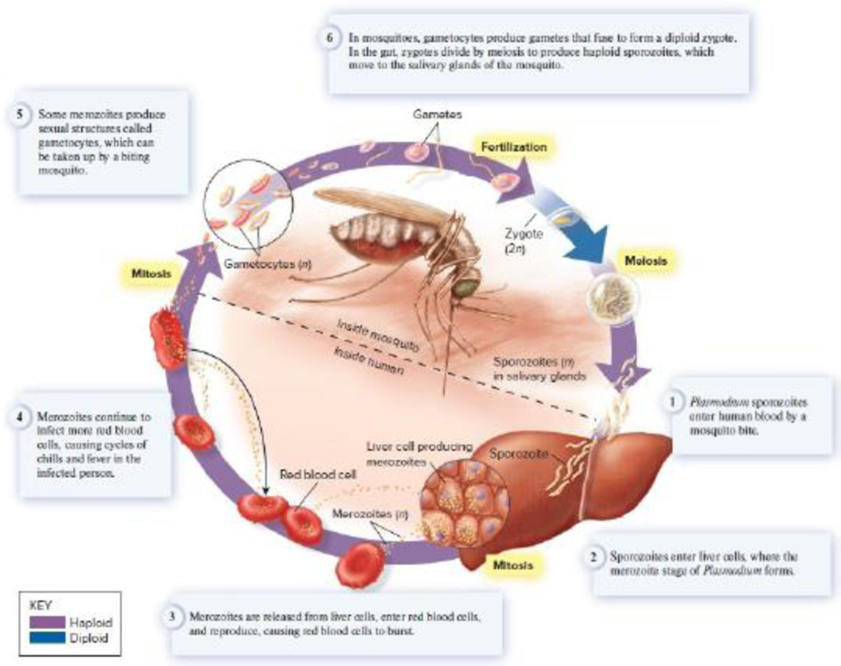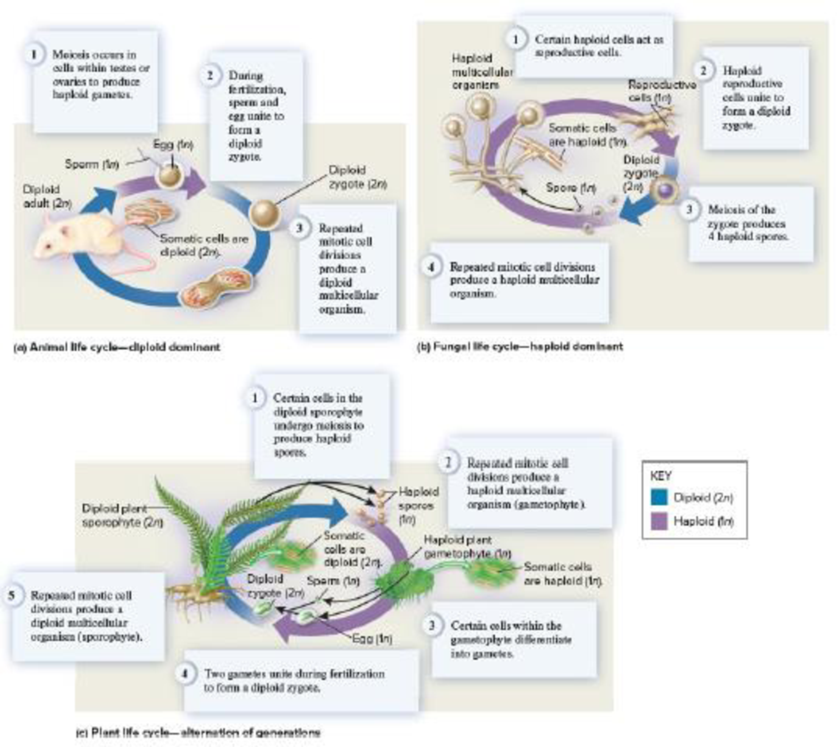
Core Skill: Modeling The goal of this modeling challenge is to make a simplified model of the one shown in Figure 28.29, to determine if the latter represents a life cycle that is diploid dominant, haploid dominant, or an alternation of generations.
Modeling Challenge: Chapter 16 describes the three basic types of eukaryotic sexual life cycles (refer back to Figure 16.14). These cycles are modeled by circular diagrams that show life phases connected by the processes of fertilization, meiosis, and mitotic cell divisions. Animals display a diploid-dominant life cycle;

Figure 28.29 Diagram of the life cycle of Plasmodium falciparum, a species that causes malaria in humans. This life cycle requires two alternate hosts, humans and Anopheles mosquitoes. Parasite life stages known as sporozoites are transmitted by a mosquito bite, then infect the liver. The parasite life stages known as merozoites are produced in the liver, and infect red blood cells.

Figure 16.14 A comparison of three types of life cycles for sexually reproducing organisms.
Want to see the full answer?
Check out a sample textbook solution
Chapter 28 Solutions
Biology
- Task: Show your work/explain your reasoning as much as possible. Grading Criteria: I want the correct answer and I want to see your work or read an explanation of your reasoning. Question: If a certain species has a DNA content of 5 picograms in each diploid cell's nucleus when the cell in in G1 of the cell cycle, what would be the expected DNA content (in picograms) of a diploid cell (from the same species) in mitotic prophase? Explain your reasoning. Consider ploidy changes and/or chromosome form changes, if applicable, when explaining your reasoning.arrow_forwardtopic: elodea 2. what do you think the purpose of cyclosis is?arrow_forwardGuide Questions: Explain your answer and cite references in APA format. 1. What does mashing do to the fruit? 2. Why did you add detergents? 3. What do you think the ethanol does? Why can't we use room temperature ethanol? 4. To extract DNA from cells, what must you isolate it from in the case of a plant such as strawberry? 5. Look at your container, what do you see in the top portion of the liquid? 6. Is the DNA you extracted is pure? What are the possible impurities? 7. What can we do with the DNA once we have purified it? Discuss different techniques and technologies associated with this. 8. Imagine that there is an E. coli outbreak in your area, and you would like to test the kangkong from your local grocery store. How could you modify this protocol to extract DNA from the kangkong (to identify the species) and check for presence or absence of E. coli.? Keep in mind that (i) E. coli is free-living and not an endosymbiont, and (ii) plant cells are encased in both a cell membrane and…arrow_forward
- Please ASAP Consider a diploid species with a deploid number 2. Show your work and explain your part. A. If a typical haploid gemete from this species contains DNA with a mass of 36 picograms of DNA would be in a typical somatic cell in G1 of the cell cycle?arrow_forwardIDENTIFICATION (Subject - Development Biology) 1. It is a chemical substances causing developmental abnormalities in the organism? 2. Its a visible rings produced from repeated DNA replication without separation of the newly formed stands? 3. What hormones responsible for molting in insects?arrow_forwardTask: Show your work/explain your reasoning as much as possible Grading Criteria: I want the correct answer and I want to see your work or read an explanation of your reasoning. Question If a certain species has a DNA content of 12 picograms in each diploid cell's nucleus when the cell in in G1 of the cell cycle, what would be the expected DNA content (in picograms) of a triploid cell (from the same species) in mitotic prophase? Consider ploidy changes and/or chromosome form changes, if applicable, when explaining your reasoning.arrow_forward
- Compare the possible differences between a eukaryotic protein-encoding gene cloned by PCR and the same gene cloned by reverse transcriptase PCR (RTPCR).arrow_forwardQ1. a. Manually, using a pencil, draw a cell in anaphase II from an organism in which 2n = 2 and each chromosome is metacentric. b. Given that each G1 nucleus from this organism contains 16 picograms of DNA, how many picograms of chromosomal DNA would you expect in the cell shown here?arrow_forwardQ6. The bacterium Rhizobium radiobacter is well known to biologists because it has the rather astonishing ability to cause natural genetic engineering. That is, several genes are moved from the bacterial cells directly into the nucleus of cells of many higher plant species. Expression of these transferred genes in the infected plants stimulates cell division, creating a mass of undifferentiated tissue. Which of the following signals on these transferred genes could be recognized in the plant host cell but not in the original Rhizobium cell? “TATA” box transcription terminator hairpin loop intron splice signals SD box A. 1, 2 and 3 B. 1 and 3 C. 2 and 4 D. 4 only E. All of 1, 2, 3 and 4arrow_forward
- Discuss how qPCR, DNA microarrays (DNA chips), and RNA-seq analysis are used to compare levels of gene expression among normal versus diseased tissues.arrow_forwardNeed help with three question. Multiple choise. 1.) How is the outcome of meiosis different from the outcome of mitosis? a.) The daughter cells produced in mitosis are genetically different from the parent cells, but have the same number of chromosomes, while these are genetically similar in case of meiosis and have fewer chromosomes. b.) The daughter cells produced in mitosis are genetically similar to the parent cells and have the same number of chromosomes, while these are genetically different in meiosis and have half the number of chromosomes. c.) The daughter cells produced in both cases are genetically similar to the parent cells, but in meiosis, there are fewer chromosomes. d.) The daughter cells produced in both cases are genetically different, but in mitosis, there are fewwer chromosomes in daughter cells. 2.) What would be the effect on the number of chromosomes in gametes due to non-disjunction? a.) The chromosome number of the gametes remains the same as the parent…arrow_forwardNeed help on three multiple questions. 1.) How is the outcome of different from the outcome of mosis? A.) The daughter cells produced in mitosis are genetically different from the parent cells, but have the same number of chromosomes, while these are genetically similar in case of meiosis and have fewer chromosomes. B.) The daughter cells produced in mitosis ate genetically similar to the parent cells and have the same chromosomes , while these are genetically different in merosis and have half the number of chromosomes. C.) The daughter cells produced in both cases are genetically similar to the parent cells, but in there are fewer chromosomes . D.) The daughter cells produced in both cases are genetically different but in mitosis , there are fewwer chromosomes in daughter cells 2.) Pine trees and moss show alternation of generations in their life cycle. During the life cycle of pine and moss A.) the sporophyte stage is dominant B.) the gametophyte is diploid C.) meiosis…arrow_forward
 Biology (MindTap Course List)BiologyISBN:9781337392938Author:Eldra Solomon, Charles Martin, Diana W. Martin, Linda R. BergPublisher:Cengage Learning
Biology (MindTap Course List)BiologyISBN:9781337392938Author:Eldra Solomon, Charles Martin, Diana W. Martin, Linda R. BergPublisher:Cengage Learning
